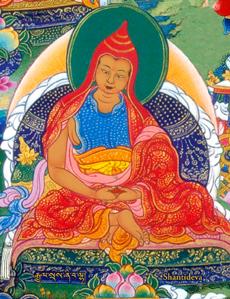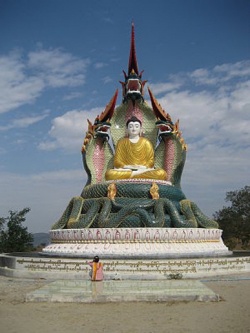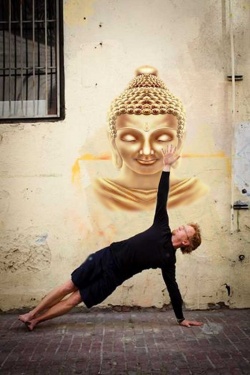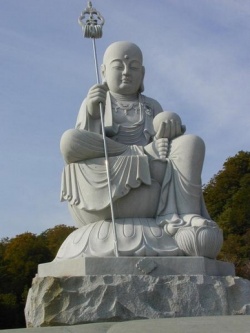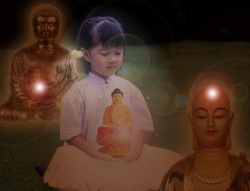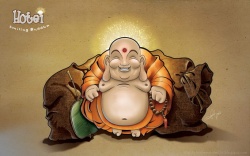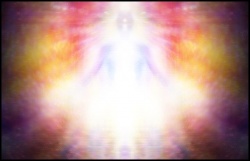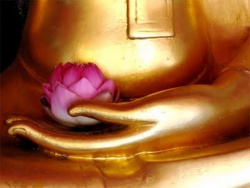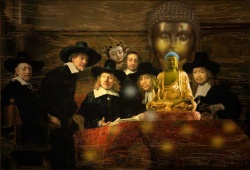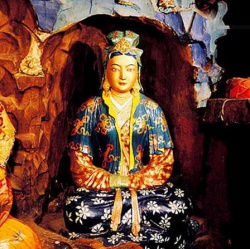Shantideva
ཞི་བ་ལྷ།; Śāntideva; Shantideva; The Idle Monk;
[[Shantideva] (Skt. Śāntideva; Tib. ཞི་བ་ལྷ་, Shiwa Lha; Wyl. zhi ba lha) (c.685-763) — a great master, scholar, and bodhisattva, who was the author of the Bodhicharyavatara. He also wrote the Shikshasamucchaya and the Sutrasamucchaya. Under the name of Bhusuku he is listed among the eighty-four mahasiddhas.
A Biography of Shantideva
The following biography of Shantideva was given by Ringu Tulku Rinpoche in a teaching to Rigpa students; Ringu Tulku Rinpoche based his biography on Drops of Nectar, a commentary on the Bodhicharyavatara by Khenpo Kunpal.
- As Khenpo Kunpal explains, Shantideva was born in the South of India, in a place called Saurastra. His father was King Kalyanavarnam, and his given name was Shantivarnam. When he was young, he naturally acted in the way of a bodhisattva. He had a great faith in the Mahayana teachings, great respect for his teachers, and he was diligent in his studies. He was always helpful to the king’s ministers and to all the subjects. He was very compassionate to the poor, the sick, and the lowly, giving them aid and protection. He also became very learned and skillful in all the arts and sciences.
- During his youth, he met a wandering yogi who gave him the teachings on the Tikshna Manjushri Sadhana, and through this practice he established a strong connection with the bodhisattva Manjushri and attained a high level of realization.
- When Shantideva’s father passed away, the ministers of the kingdom wanted to make Shantideva the next king, and they prepared a great throne for his enthronement ceremony. But the night before he was to be enthroned, Shantideva had a dream in which he saw Manjushri sitting on his throne, and Manjushri said, “My son, this is my seat, and I am your teacher. How can we two sit on the same seat?” Shantideva interpreted the dream as an indication from Manjushri that it is no use to become king. So he fled the kingdom, leaving everything behind.
- He went to the monastic university of Nalanda, where he become a monk under Jayadeva, who was the head of the five-hundred panditas (scholar-practitioners) at Nalanda. It was at that time that he was given the name Shantideva.
- At Nalanda, Shantideva studied all the teachings of the three pitakas and meditated on their meaning. But he studied and practised on his own, in private, and within himself, focusing on the meaning of the teachings and practice. He secretly composed two treatises that condensed the meaning of the pitakas: the Compendium of Trainings and the Compendium of Sutras.
- Although Shantideva had these great qualities of realization and renunciation, he remained in Nalanda without doing anything outwardly. To the other students, he seemed to be the laziest person there, so they called him bhusuku. Bhu comes from bhukta, which means eating. And su comes from susta, which means sleeping. And ku comes from kuchiwa, which means just walking. So bhusuku is one who just eats, sleeps, and goes out to the toilet.
- The students at Nalanda thought that he was a disgrace to them, because everybody else was studying and debating and giving teachings—everybody was busy doing something, and Shantideva was doing nothing. He was just sleeping in his small room, eating their food, and strolling around. They wanted to expel him, but they couldn’t find an excuse to expel him because he had done nothing wrong—because if you don’t do anything, you can’t do anything wrong! So he didn’t break any rules or do anything that was against the law. Since they couldn’t just ask him to go away, they tried to find a way to drive him away.
- Then somebody had a great idea and said, “We should make a new system that all the students in the university have to give a teaching. When his turn comes, he won’t know how to teach, so he will run away!” They all agreed to this and they asked Shantideva to give a teaching. But Shantideva wouldn’t agree to teach. He just said, “Oh, please don’t ask me. I don’t know anything.” So they asked his teacher to order him to teach. So Shantideva’s teacher ordered him to teach, and then Shantideva agreed to teach.
- By now the other students really wanted to embarrass him, so they built a huge throne and put it at the center of a big open field, and then they invited everybody from the whole community around the university to come and listen to Shantideva. They really wanted to make him run away!
- Finally, when the time came for him to give the teaching, Shantideva just appeared on the throne. No one saw him arrive or climb onto the throne, and they couldn’t figure out how he got there. Then Shantideva said, "What kind of teaching should I give? Something that has been given before, or something which has never been given before?” Of course, everybody shouted, “Something that has never been given before!”
- Shantideva replied, “I have these three teachings. Compendium of Trainings is too long, and Compendium of Sutras is too short, therefore I will give you the Bodhicharyavatara, which is of middle length.”
- Shantideva then recited the Bodhicharyavatara from memory, and it is said that many people saw Manjushri in the sky above his head as he recited the text. Legend has it that when Shantideva reached the thirty–fourth verse of the ninth chapter, which is the most difficult part of the book, he and Manjushri levitated off the ground, and rose up higher and higher into the air until they disappeared. Shantideva's voice could still be heard until he finished the teaching.
- Afterwards, everyone was very impressed! A few panditas with extraordinary memory had written down notes, but when they tried to compare their notes, there were two different opinions on what was said. According to the panditas from Kashmir, the text had nine chapters and seven hundred stanzas. But a group of panditas from central India thought it had ten chapters and one thousand stanzas. In addition, they did not know what Shantideva meant by these two books, Compendium of Trainings and Compendium of Sutras, which were referred to in the teaching.
- So they searched for Shantideva all over India, and after quite some time they found him at the stupa of Shridakshina, in the south. The Nalanda scholars went there and invited Shantideva to come back to Nalanda and teach. He would not go with them, but he settled their disagreement about the text, and said that it has ten chapters and one thousand stanzas. Then he told them where to find the two other books that he had written: Shantideva had written the texts on palm leaves and hidden them under the thatched straw roof in his room. He also gave them the reading transmission and explanations of these texts.
- The three books written by Shantideva are Compendium of Trainings, which is quite long, Compendium of Sutras, which is very short, and Bodhicharyavatara, which is of medium length. The Bodhicharyavatara was written for all beings generally, but especially for these five hundred panditas of Nalanda University, to show them the genuine path of a bodhisattva. It is said that there were one hundred and eight commentaries written on the Bodhicharyavatara in India.
The Philosophical View of Shantideva
The writings of Shantideva were based on the Mahayana Buddhist tradition. Within the Mahayana tradition in India, three main schools of thought developed: Chittamatra, Svatantrika-Madhyamika, and Prasangika-Madhyamika. Shantideva's writings fall within the Prasangika-Madhyamika method of Buddhapalita and Chandrakirti.
See Also; Nalanda.
Further Reading
- Abhayadatta, Buddha's Lions: Lives of the Eighty-four Siddhas, Emeryville, Dharma Publishing, 1979
- Dowman, Keith, Buddhist Masters of Enchantment: The Lives and Legends of the Mahasiddhas, Inner Traditions, 1998
- Lobsang N. Tsonawa, Indian Buddhist Pandits from The Jewel Garland of Buddhist History, Dharamsala: Library of Tibetan Works and Archives, 1985.
- David Seyfort Ruegg, The Literature of the Madhyamaka School of Philosophy in India, Wiesbaden: Harrassowitz, 1981, pp. 82-86
- J.W. de Jong, 'La légende de Śāntideva' in Indo-Iranian Journal, 16, 1975 pp.161-182
External Links
Source
Shantideva (Sk: Śāntideva; Zh: 寂天; Tib: ཞི་བ་ལྷ། (Shyiwa Lha, Wylie: zhi ba lha); Mn: Шантидэва гэгээн) was an 8th-century Indian Buddhist scholar at Nalanda University and an adherent of the Madhyamaka philosophy of Nagarjuna.
Biography
The Chan Ssu Lun of the Chinese Madhyamika school identifies two different individuals given the name "Shantideva": the founder of the Avaivartika Sangha in the 6th century, and a later Shantideva who studied at Nalanda in the 8th century who appears to be the source of the Tibetan biographies. Archaeological discoveries support this thesis. Two Tibetan sources of the life of Shantideva are the historians Butön and Jetsün Tāranātha. Recent scholarship has brought to light a short Sanskrit life of Shantideva in a 14th century Nepalese manuscript. An accessible account that follows the Butön closely can be found in Kunzang Pelden, The Nectar of Manjushri's speech.
Shantideva was a Brahmin in the southern country of Saurastra (in modern Gujarat), the son of the King Kalyanavarman and he went by the name Shantivarman.
Works
Śikṣāsamuccaya
The Śikṣāsamuccaya (“Training Anthology”) is a prose work in nineteen chapters. It is organized as a commentary on twenty-seven short mnemonic verses known as the Śikṣāsamuccaya Kārikā. It consists primarily of quotations (of varying length) from sūtras, authoritative texts considered to be the word of the Buddha — generally those sūtras associated with Mahāyāna tradition, including the Samadhiraja Sutra.
Bodhicaryavatara
Shantideva is particularly renowned as the author of the Bodhicaryavatara (sometimes also called the Bodhisattvacaryavatara). An English translation of the Sanskrit version of the Bodhicaryavatara is available online, as well as in print in a variety of translations, sometimes glossed as A Guide to the Bodhisattva's Way of Life or Entering the Path of Enlightenment. It is a long poem describing the process of Enlightenment from the first thought to full Buddhahood and is still studied by Mahayana and Vajrayana Buddhists today. An introduction to and commentary on the Bodhicaryavatara by the 14th Dalai Lama called "A Flash of Lightning in the Dark of Night" was printed in 1994.
A commentary on the Patience chapter was provided by the Dalai Lama) in "Healing Anger" 1997, and his commentaries on the Wisdom chapter can be found in "Practicing Wisdom" 2004. Also Geshe Kelsang Gyatso published a translation titled "Guide to the Bodhisattvas Way of Life" in 2002. His line by line commentary to the entire root text is entitled "Meaningful to Behold – The Bodhisattva's Way of Life " 1980. His extensive commentary to the patience chapter is called "How to Solve our Human Problems", 2005. Kunzang Pelden has written a commentary based on that given by Patrul Rinpoche, translated by the Padmakara Translation Group. Patrul Rinpoche was a wandering Monk of great scholarship, who dedicated his life to the propagation of the Bodhicharyavatara.
Just as the stem of a banana tree does not exist when it has been divided into parts, the ego likewise becomes unreal when examined reflectively.
One might think that because no being can be discovered, there are none on whom to bestow compassion, but what is done even in confusion is because of a purpose.
If, however, there is no being, whose is the purpose? The effort is illusory, but because it serves to tranquillize sorrow, this delusion is not forbidden.
When, through my effort and by raising a cloud of merit, may I make tranquil those who are troubled in the fire of sorrow?
When, by zealous and meritorious deeds for the unveiling of the truth, may I point towards shunyata those who see only fantasies?
Bodhicaryavatara SHANTIDEVA
Chandrakirti laid the foundations and initiated the Prasangika Madhyamika school of Buddhist thought, but Shantideva provided it with mystic vision and ecstatic fervour. Born in the eighth century, he was a son of the ruler of Saurashtra, a small kingdom in modern Gujarat. While still a child, he was vouchsafed a vision of Manjushri, the Bodhisattva of wisdom, and the vision was repeated near the time for his accession to the throne. Manjushri declared that he was Shantideva's alyanamitra, spiritual friend, and warned him not to take the throne of Saurashtra. At about the same time, Shantideva had a dream in which Tara, the feminine aspect and counterpart of Avalokiteshvara, appeared to him in the guise of his mother and consecrated him. In an act reflecting the renunciation of Buddha, he fled the kingdom and wandered in a forest for twenty-one days. He came upon a woman who offered him sweet water and led him to a yogin who initiated him into Buddhist doctrine and meditation. He soon attained samadhi and recognized the woman and the yogin as Tara and Manjushri. From that moment, the vision of Manjushri remained with him throughout his life.
In time he came to Nalanda, where he received ordination and the name Shantideva from the upadhyaya Jayadeva. Since he ate large quantities of rice and seemed to sleep much of the time, many monks suspected that he was a spiritual fraud. To unmask his pretensions, they set up a recitation of the sutras from memory, expecting him to fail when his turn came around. When it was his time to recite, he asked if they would like to hear an old sutra or something wholly new. They chose the latter, and he at once began to utter the Bodhicaryavatara (Entering the Path of Enlightenment), a poetic and philosophical discourse on the Bodhisattva Path. When he began to utter the verse (IX, 35), "When existence and non-existence cease to be present to the mind. . . ", he rose into the air and became invisible, though his voice could be clearly heard. There was no more gossip in Nalanda regarding Shantideva's routines, and reverence for him was so great that he joined Chandragomin as one of the select few to whom Taranatha gave the sacred title acharya in his history of the Buddhist tradition in India.
While at Nalanda, Shantideva also composed the Shikshasamuccaya, a compendium of Buddhist doctrines, which drew together citations from a vast number of sutras and texts. It emphasizes the moral dimension of the Bodhisattva Path, whilst the Bodhicaryavatara focusses on the Path from the standpoint of consciousness. Shantideva also engaged in dialectical debates, advocating a mystical view of the highest doctrines and insisting that logical clarity serve the ends of intuitive insight. According to tradition, he travelled south to a now unknown place to debate a number of tirthikas who rejected the teachings of Buddha. He won a great number of them over with his dialectical skills, and though many attested to his magical powers, his memorable "seven wonderful acts" emphasized the conversion of different groups of opponents. Sometime late in the seventh century he disappeared from history, which remains silent on the time, place and manner of his death.
For Shantideva, the key to the Bodhisattva Path is bodhichitta, the seed or thought of Enlightenment, and therefore the Bodhisattva is the paradigm of the path to Enlightenment. Because the Bodhisattva pauses at the threshold of becoming a Buddha, who assumes the Dharmakaya glory but is cut off from giving aid directly to human beings still mired in the illusion and delusion of samsara, he is suspended between the relativity of illusions and the certitude of Reality. He reaches down from the realm of pure thought to help all those willing to attempt to tread the path he has trodden. Whilst the Arhat and the Bodhisattva are the same in their ultimate natures, the Arhat seizes the Enlightenment he has earned and becomes an example for others to follow. The Bodhisattva holds back in some mysterious way, inexplicable to ordinary consciousness, and actually reaches out to help those who would walk the Path. The unfathomable mystery of this aid is bound up with bodhichitta, that spark of consciousness which, when activated, turns the aspirant towards bodhi, Enlightenment. The difference between Arhat and Bodhisattva is to be found less in states of consciousness than in the linkage between that realm and the world of transient phenomena.
Since bodhichitta is not only the idea of bodhi or Enlightenment, but also its suffusion through the whole of consciousness as well as the force it exerts in impelling one along the Path, it is Buddhanubhava, the gesture of Buddha, which turns consciousness, even if only for a moment, to the good. Like a thunderbolt in the night sky, it permanently transforms one's perception of the world, giving new valence and orientation to everything in samsara. Since dukha, suffering, is the defining characteristic of temporal existence, bodhichitta is the inexplicable infusion of a higher reality into the otherwise seamless fabric of ignorance. Bodhichitta is therefore an event which falls outside the causality of ordinary mind and nature, a kind of grace from Buddha or from an enlightened Guru. It is as if shunyata, the Void, calls to the Void, and the arising of bodhichitta within one is its echo.
This merit – seed of the world's joy, medicine for the world's sorrow, jewel of chitta, the mind – how can it be measured?
Bodhichitta contains the potency necessary for the entire pilgrimage to Enlightenment, and it is the womb of karuna, compassion. With it goodness can vanquish evil, knowledge can surmount ignorance, and insight can subdue suffering. The arising of bodhichitta completes one's birth as a human being, for one becomes a Buddhaputra, a Buddha-son, a member of the Buddhakula, the Buddha family.
Because karuna is born from bodhichitta, the ray of shunyata activated in human consciousness, it is not a property of the individual or an instrument for the redemption of the individual alone. It is the alchemical source of universal purpose, the ground of mahartha siddhi, the great work, and the force within jagad dhitartha, the work of the world's well-being. For Shantideva, it is less important that one grasp the ten stages on the Bodhisattva Path than that one understand that the activation of bodhichitta compels a twofold practice. Bodhipranidhichitta, the thought of the vow of Enlightenment, spontaneously arises with the advent of bodhichitta, and it is immediately followed by bodhiprasthanachitta, the departure upon the road to realization. When one comes to the fortunate condition in which one can take the great vow, mahapranidhana, before a spiritual guide, kalyanamitra, one has not only come to an irreversible turning point in this life, but one has affected the entire cycle of samsara. The great vow is the Pledge of Kwan-Yin, and the aspiration to achieve Enlightenment cannot be separated from the Enlightenment of all beings. Bodhichitta is thus the spark of the Bodhisattva in every being, and once it is truly aroused, it becomes a consuming fire which may have setbacks but which expands without limit and can never be extinguished.
Rejoicing in the seemingly miraculous manifestation of bodhichitta within one's deepest consciousness leads naturally to an overwhelming sense of gratitude, which Shantideva expressed in terms of the Tathagatas, the Jewel of the True Dharma and all the Buddha-sons, that is, to the Buddha, the Dharma and the Sangha mystically transfigured in the light of bodhichitta. Shantideva calls upon all the great beings represented in these Three Jewels to take possession of him, for he is prepared to enter the strict servitude demanded by the bhakti, devotion, which has arisen in him. He recognizes that neither bodhichitta nor refuge in the Three Jewels excuses the aspirant from the self-engendered effort which is required on every step of the Path. For Shantideva, the first step after being caught up in spontaneous gratitude is a self-conscious act of purgation through papadeshana, the confession of sins. Papadeshana is no guilt-ridden indulgence in regret over one's past misdeeds, which at best would amount to an inadequate empirical review dependent on partial memory. Rather, it is a reflection upon the evil in the world and the recognition that, given innumerable previous incarnations, one dare not presume to dissociate oneself from any of it.
Whatever evil, on the endless wheel of samsara or just right here, whatever evil was committed by me or was caused to be committed by me, and whatever was enjoyed foolishly, ending in self-destruction, that evil I confess, stricken with remorseful feeling.
Once one's past deeds and one's connection through karma with every other living being has been honestly faced, one can authentically rejoice in everything that is good, punyanumodana, the mirror image of papadeshana. With these two comes the capacity to begin fulfilling the Bodhisattva Vow by renouncing whatever meritorious karma one might have or will receive for the uplift of all beings. Together, these form the basis and substance of bodhichittaparigraha, seizing the seed of Enlightenment and retaining its efficacious radiance throughout the whole of consciousness, so that at every moment it suffuses thought, permeates intention and manifests in deeds.
Today my birth is completed, my human nature is fulfilled. Today I have been born into the Buddha family and I am henceforth a Buddha-son. It is now for me to behave according to the customs of this family, so that there may be no stain put upon its spotlessness.
Each step on the path to Enlightenment is distinguished by the predominance of a paramita, virtue or quality of character, which synthesizes all the virtues from a particular standpoint. Though Shantideva followed the traditional Mahayana list, consisting of dana, shila, kshanti, virya, dhyana and prajna, he depicted them primarily in terms of transformations of consciousness rather than of deeds. Thus dana, love identified with giving, becomes bodhichittapramada, vigilance in the thought of Enlightenment. Noting the fact that "innumerable Buddhas have passed, seeking all beings", he lamented his self-engendered condition: "Because of my own fault, I have been beyond the reach of their medicine." Because of one's own past actions on the plane of consciousness, one has developed attractions and repulsions which are readily expressed in joys and fears, friends and enemies, pleasures and pains. Desire, hatred and anger are one's real enemies, but since they have no power in themselves, they cannot enslave one without one's own cooperation. "Yet they are dwelling within my own mind and thus smite me at their ease." Ultimately, one can neither claim to be overpowered by them nor pretend that one does not have the resources to banish them. "I am stupid only because I make no effort", Shantideva wrote, In striving for prajna, wisdom, one can overcome maya, illusion, and this requires vigilance in the thought of Enlightenment.
For Shantideva, dana and shila, as ethical principles, are on occasion potentially in opposition. From the plane of the mind, however, which is the root of ethical discrimination, they are at one. Shila, harmonious conduct, can be undertaken only if one follows shiksha, a discipline or rule of life, and this is possible only to the extent that one cultivates samprajanyarakshana, complete mental awareness or presence of mind. Since all one's enemies and fears are lodged in consciousness, anger comes easily to one who has not developed considerable mental equipoise. If anger can be eradicated, Shantideva taught, all one's fears and enemies will vanish. Thus awareness is shila in consciousness, and all who would walk the Bodhisattva Path must strive for it, though those who have the indescribable good fortune of association with a Guru will find themselves immensely aided. The ability to discern when the dictates of love for all beings requires one to ignore conventional morality, and when dissipative circumstances indicate that one's giving should be checked, is developed through the performance of duty. For the performance of duty to be an effective means of treading the Path, one has to bring one's whole attention to each act undertaken. In addition, one needs to shift attention from self-interested concern with the body to protecting the mind. By strengthening awareness and guarding consciousness from distractions and illusions, one makes oneself an instrument of service in the cause of universal welfare.
Kshanti, patience, implies forbearance, forgiveness and tolerance at the broadest possible level. It is patience in respect to oneself and one's imperfections, to karma which is exact, relentless and just, and to others. All levels of patience have hostility as their opposite, and hostility of any kind undermines what one has garnered from the arising of bodhichitta and works against the Vow one has taken to help redeem all beings from the bonds of conditioned existence. For Shantideva, the dialectical paradoxes familiar to Madhyamika thought and the theme of the Prajnaparamita Sutras are powerful levers for the permanent reorientation of consciousness. Though one wishes to help all beings reach Enlightenment, one also knows that no independent beings actually exist. Rather than appropriating this doctrine to justify inaction, one should recognize that if it is so, there is no one and nothing towards which one need be hostile. If, as Buddha taught, the fundamental condition of samsara is dukha, then patience is critical to nurturing bodhichitta in the world. Through patience, one can come to endure a modicum of suffering without having to flee it or become obsessed with it. That degree of indifference can be extended gradually until neither pleasure nor pain of any intensity can divert one from the self-selected Way. Kshanti is therefore the best tapas, purgative discipline, and it allows one to take the Bodhisattva Vow at a new level of understanding and dedication.
Let this, then, be my vow: the honouring of the Tathagata, the complete fulfilment of my own well being, the destruction of the sorrow of the world.
To the extent that one has secured the foundations of patience, one can begin to manifest virya, which for Shantideva is effort, heroism and a kind of pride.
Self-mastery, aiming at courage and attainment of strength, identity of self and others, and likewise, exchange of self and others, are all aspects of virya.
One's tolerance and patience must not be allowed to lull one into complacency. Rather, they should prepare one for a fierce and unrelenting struggle to achieve the goal. Having learnt to face karma and suffering, one should gain the strength to do something about them. Though Shantideva was well aware of the disease of separative pride, which destroys if not itself destroyed, he saw that even it is only a pitiful reflection of a virtue. True pride, mana, is a will to persevere on behalf of all. One should so solidly identify with all beings that one is too proud to labour for the separative and false ego, or to allow distasteful work to be done by others, or even to permit the thought of giving up to cross one's mind. One should think too much of oneself as a being ultimately not different from all the beings in existence to shun ruthless examination of one's faults and fearless correction of one's mistakes.
As cotton is obedient to the coming and going of the wind, so one should proceed in obedience to one's resolution. Thus riddhi, the wonder-working power, is utterly triumphant.
The practice of virya as a mental activity manifests as wakefulness, heedfulness and concentration, and it is sometimes called 'unbounded industry'. At the same time, it is a commensurate tranquillity of mind. The energy released by this combination provides the basis for dhyana, contemplation, reflection and abstraction, which culminates in samadhi, full meditation. Shamatha, alert tranquillity, opens the way to vipashyana, clear vision. Although vision is possible long before this stage is reached, the recurrence of (or even the potential for) passionate attraction and revulsion discolours it. In dhyana one can gain from one's visions the assurance that, though they will be partial revelations of Truth, they will not be distorted or inverted. Vipashyana is the recognition of things as they are, and this supreme clarity of mind results in total detachment and renunciation of the fruits of action. Having vowed from the beginning to serve the spiritual welfare of all beings, and making real through detachment the ultimate equality of all beings, the Bodhisattva participates in a great alchemical mystery through dhyana, the efflorescence of quiet consciousness.
Whoever wishes quickly to rescue himself and another, should practise the supreme mystery – the exchanging of himself and the other.
Ethically, this is the recognition of the virtues in others and the faults in oneself, followed by an exchange in which one seeks to emulate those virtues by exalting and not stealing them. On the plane of clear mind, it is the realization that one is not separate from others and that karma is understood fully only at the collective level. Psychologically, it is the willingness to assume the suffering of another and replace it with one's own bliss. But on a deeper, occult plane which does not exclude other levels, it is the alchemical magic of lending one's consciousness and insight to another, giving invisible strength through meditation without removing the responsibility of another for his or her condition. This is the mysterious wonder-working power which Buddha called the highest magic, easily misunderstood as vicarious atonement, but in fact the fundamental force at the root of all the siddhis or supernormal powers. Thus the Bodhisattva becomes a pillar of the world, uplifting the whole of humanity, though unseen and unknown to most beneficiaries.
Secure in dhyana and beyond the possibility of retreat on the Bodhisattva Path, the traveller finds himself at the threshold of prajna, perfect wisdom beyond all conceivable formulation. Relative truths, many of which have been helpful, like a raft crossing a river, are left behind once the raging waters are crossed, and one stands before paramartha, "that which is beyond the veiled". Truth, satya, is seen to be shunyata, a void into which all relativities and partialities are dropped, an emptiness in which there are no attitudes but a universal orientation. In its ineffable radiance one sees that which is beyond form and formlessness, and one rejoices in the realization that there are no beings to be redeemed, though one will labour without cessation to redeem every being. The Bodhisattva now knows, and though that knowledge cannot be communicated to others but only intimated through symbol, metaphor and analogy, he can act on it while not seeing himself as the actor. The fusion of perceiver, perception and perceived is as complete as it is inexplicable. The Bodhisattva now bears that revered designation in its highest meaning, and his signature is selflessness His radical identification with all beings restrains him from disappearing in the release of Nirvana. Rather, in parinamana, that unspeakable consummation which is attaining the Goal, he now breathes and thinks for humanity, his every word a living balm and every act a benediction.
As Manjushri walks in ten directions and to the sky's edge for the increase of the prosperity of all beings, let my work be like his. As long as there is space and as long as the world exists, for that long let my existence be devoted to the world's sorrows.
Wherever is found the sorrow of the world, may it come to fruition in me, and may the world be comforted by the glorious host of Bodhisattvas.
As the only medicine for the world's sorrow, the only cause of happiness and success, may the Teaching – honoured everywhere – endure for long aeons.
I pay homage to Manjughosha by the favour which makes the thought beautiful. I honour the kalyanamitra, the good friend, by the favour which he has thus increased.
______________
Regard as true Renouncer him that makes
Worship by work, for who renounceth not
Works not as Yogin. So is that well said:
"By works the votary doth rise to saint,
And saintship is the ceasing from all works";
Because the perfect Yogin acts – but acts
Unmoved by passions and unbound by deeds,
Setting result aside.
Source
